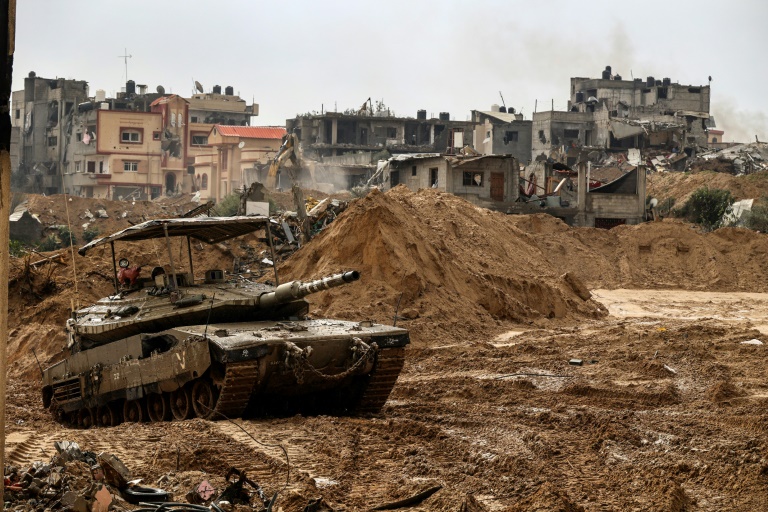Khan Yunis, epicentre of Gaza war

This picture taken during a media tour organised by the Israeli military on January 27, 2024 shows an Israeli army tank rolling in Gaza’s main southern city of Khan Yunis
Khan Yunis – Tanks churn through the mud between bombed-out buildings in Gaza’s main southern city of Khan Yunis, now the epicentre of the war, as explosions and gunfire reverberate in the distance.
Piles of rubble tower near the entrance to a Hamas tunnel, part of the underground labyrinth the army dubs the “Gaza Metro” and where it says militants are hiding out and holding hostages.
In the bloodiest ever Gaza war, now in its fourth month, the army has concentrated its operations in Khan Yunis, the hometown of Hamas’s Gaza leader Yahya Sinwar, the alleged architect of the October 7 attack.
The Israeli army recently led a group of journalists through a long tunnel it said had been dug by Hamas below the city, much of which lies in ruins after weeks of bombing and heavy combat.
Taken below ground, reporters were told they were walking through a tunnel hundreds of metres long leading towards a cemetery — locations AFP was not able to independently verify.
“We are in the middle of a cemetery in Khan Yunis and this cemetery is a military compound — a Hamas military compound, over and underground,” said Dan Goldfus, an Israeli commander leading the group.
“Look at the time, the money and the effort that’s been put into this tunnel,” Goldfus said as he patted a concrete wall of the tunnel leading to a series of larger rooms.
One of the biggest chambers was large enough to hold more than a dozen troops, and the Israeli army said it had served as a command centre for the Palestinian militant group.
Inside, there was a large kitchen with a sink full of dirty dishes and empty cans of chopped vegetables.
The Israeli army says that many hostages taken by Hamas on October 7 have been or continue to be held in the vast network of tunnels like these that spreads beneath Gaza.
Above ground, tanks and earth diggers roamed the deserted streets searching for more underground Hamas facilities, an AFP video journalist who was part of the group reported.
Troops patrolled neighbourhoods that had been reduced to rubble, with no civilians in sight.
– Pockmarked buildings –
Rows of pockmarked buildings, including some with gaping holes in them, and destroyed houses lined a road muddied by recent heavy winter rain as a convoy of troops drove through.
Mangled and charred remains of vehicles and metal scrap were piled on both sides of the road as the convoy passed, with at least two tanks among the armoured vehicles.
The conflict erupted after Hamas’s October 7 attack on Israel which resulted in about 1,140 deaths, mostly civilians, according to an AFP tally of official figures.
Aiming to destroy Hamas, Israel launched a relentless bombardment of Gaza and the ground invasion that started in northern Gaza and has steadily moved south since.
So far, the offensive has killed at least 26,422 people in Gaza, most of them women and children, according to the health ministry in the Hamas-run territory.
Militants also seized about 250 hostages and Israel says around 132 of them remain in Gaza, including the bodies of at least 28 dead captives.
The labyrinth of tunnels beneath the coastal territory was initially devised as a way of circumventing the crushing Israeli-Egyptian blockade on Gaza, in place since 2007.
Since a 2014 war with Israel, the tunnel network has been expanded and Hamas has made frequent use of it to facilitate its rocket launches.
A study published on October 17 by the Modern War Institute at the US military academy West Point said there were 1,300 tunnels stretching over 500 kilometres (310 miles).
Goldfus said the tunnels had become a defining feature of the war.
“Every war has its own characteristics and I think that this war, its basic character is about that over and underground manoeuvre,” he said. “That’s the character of this war.”
